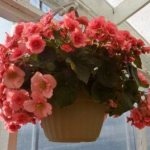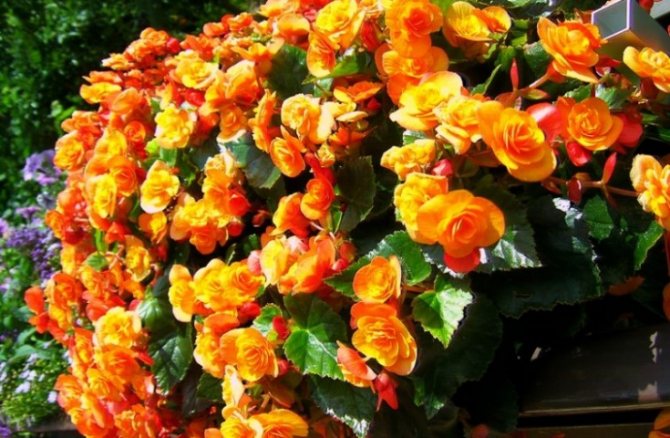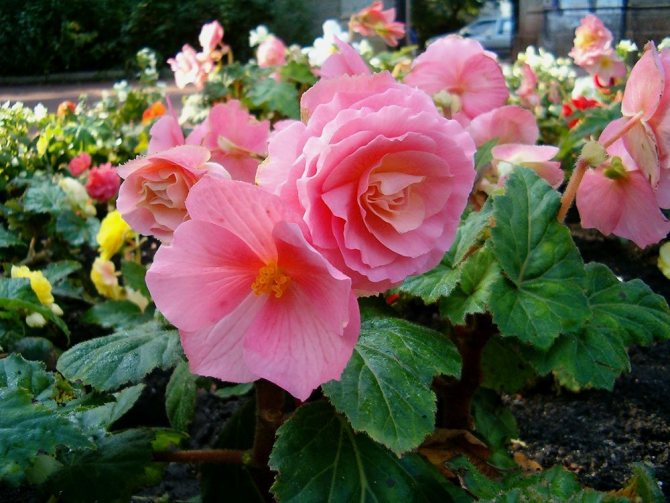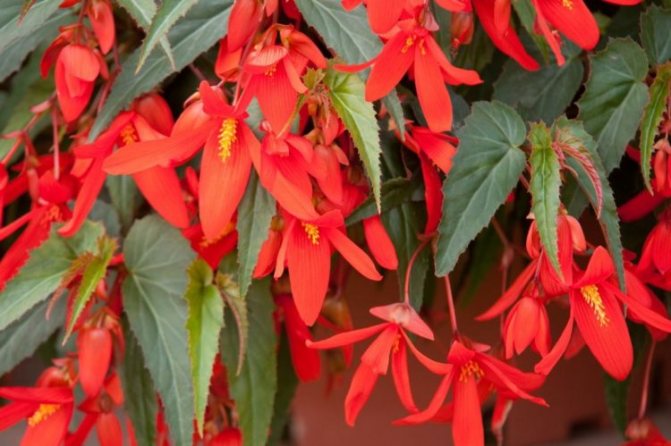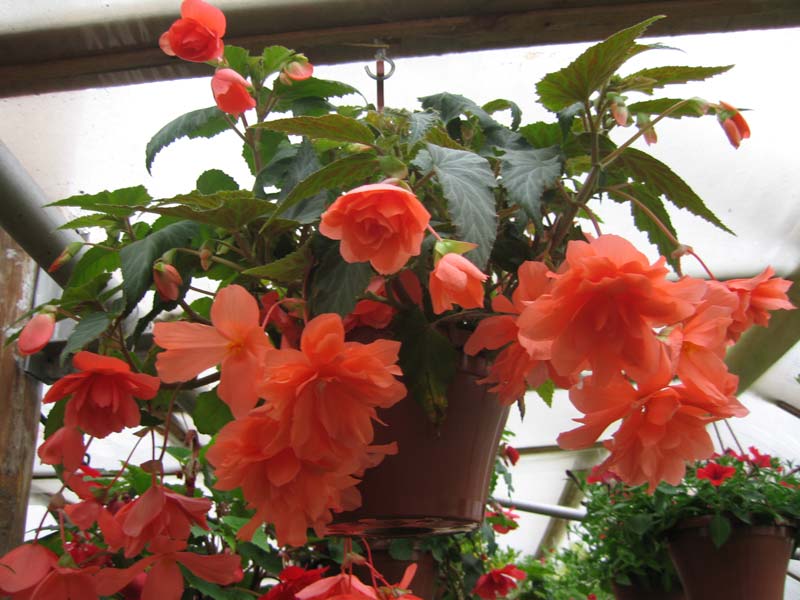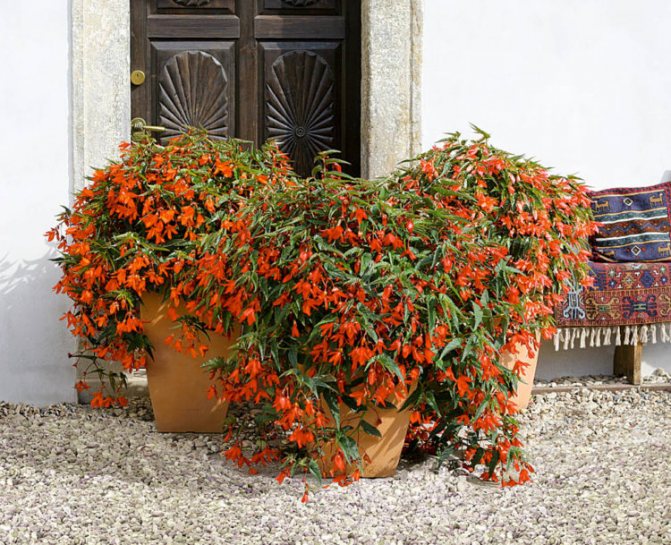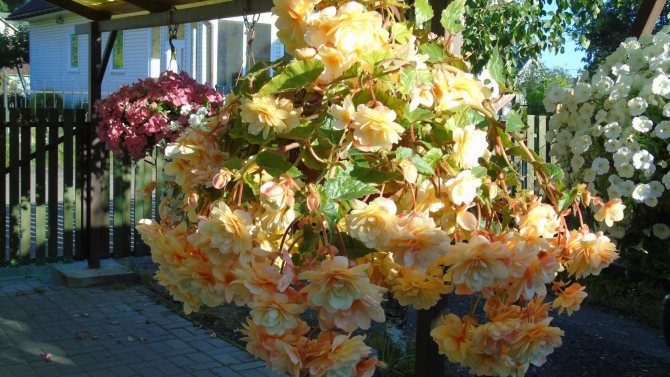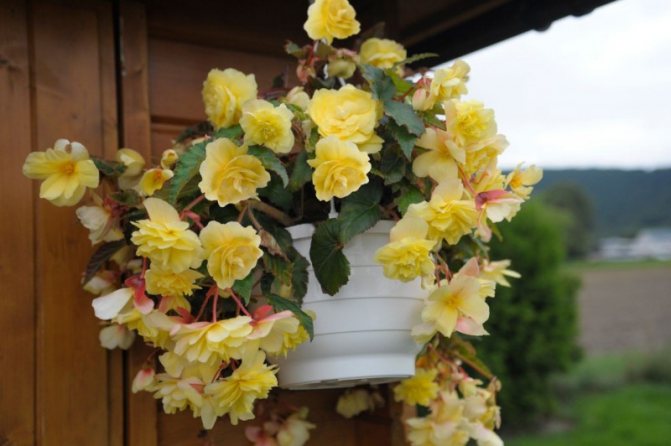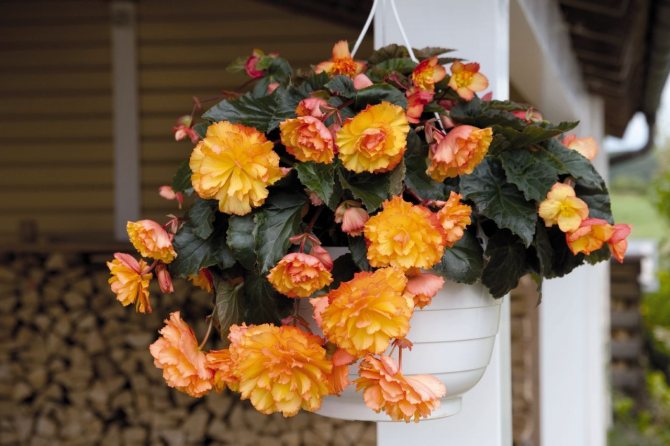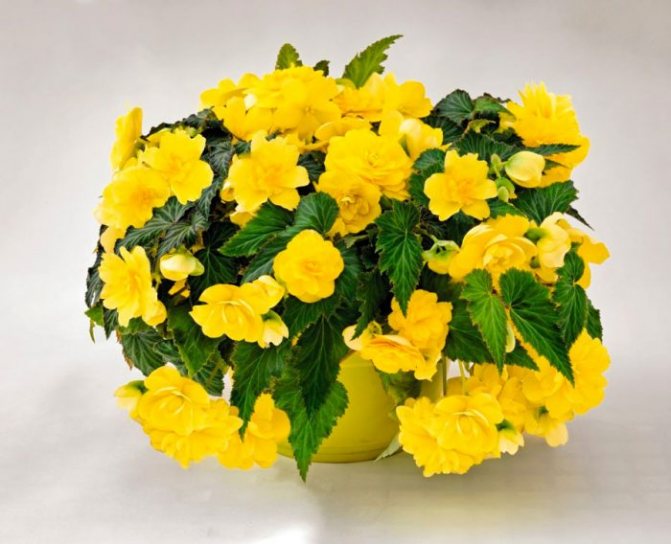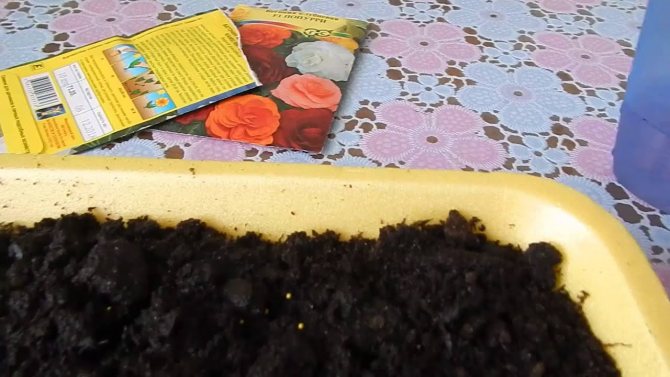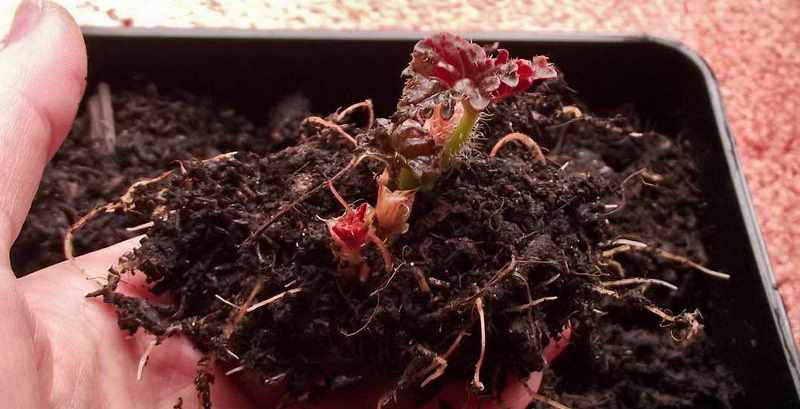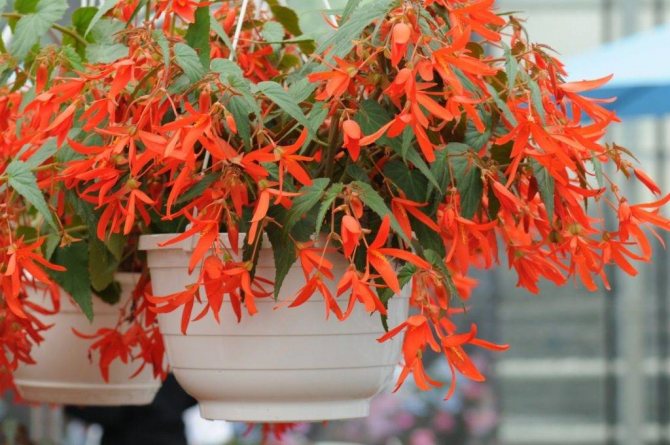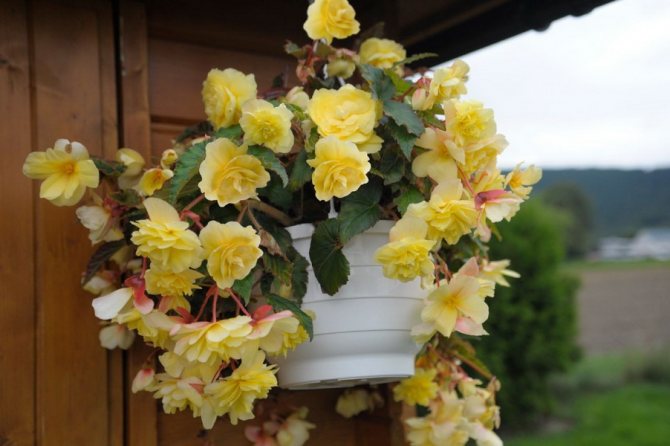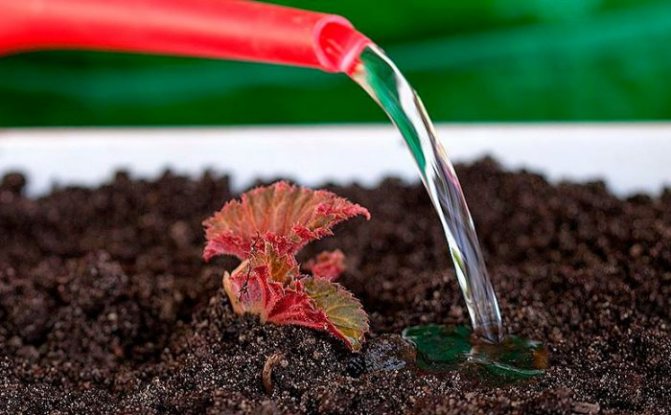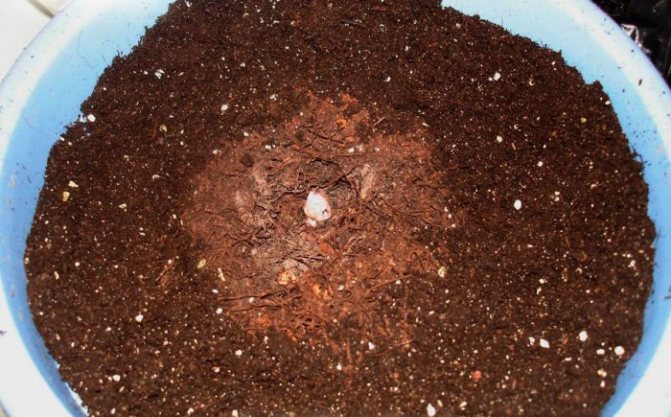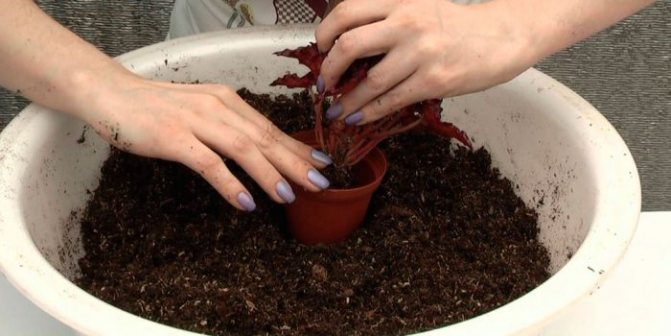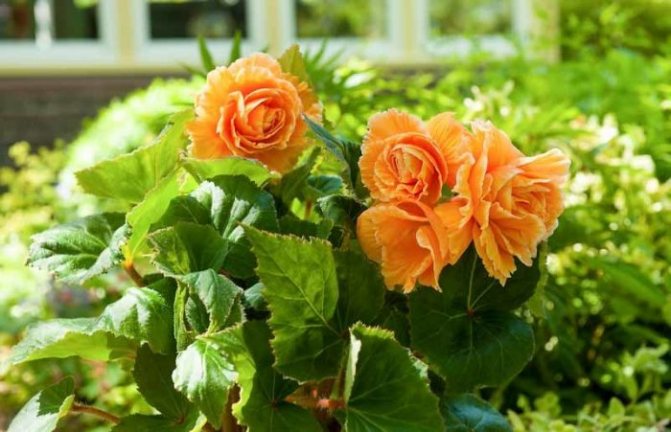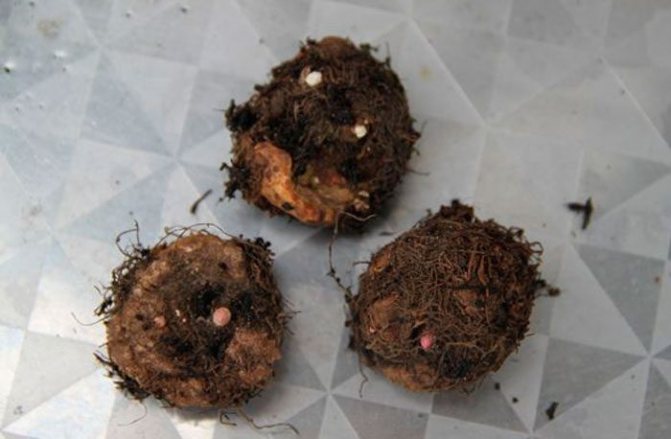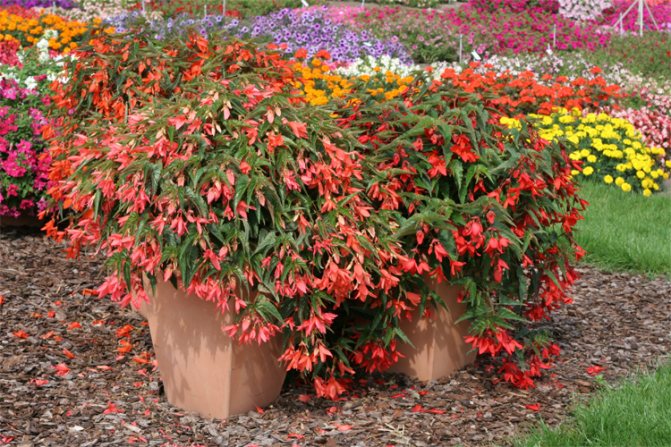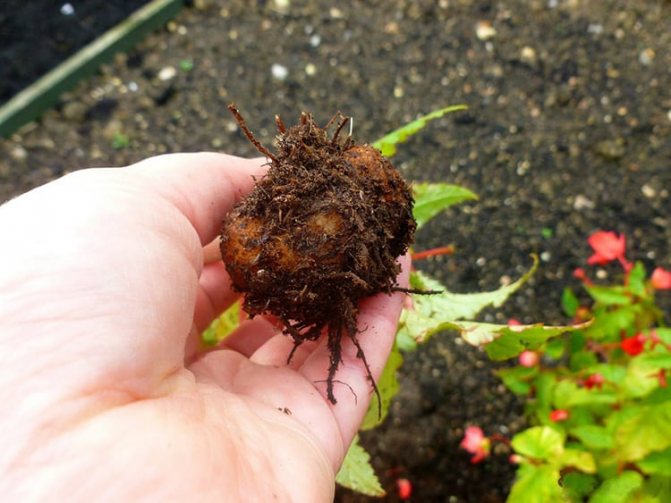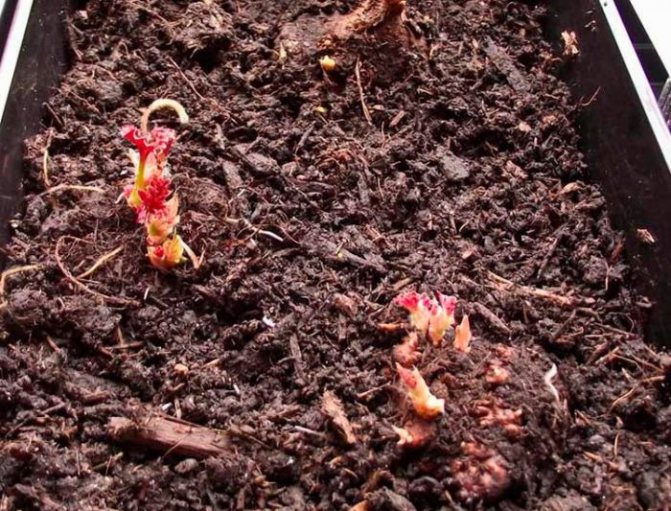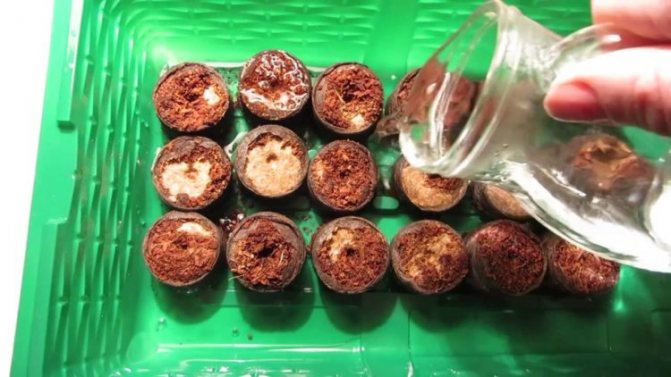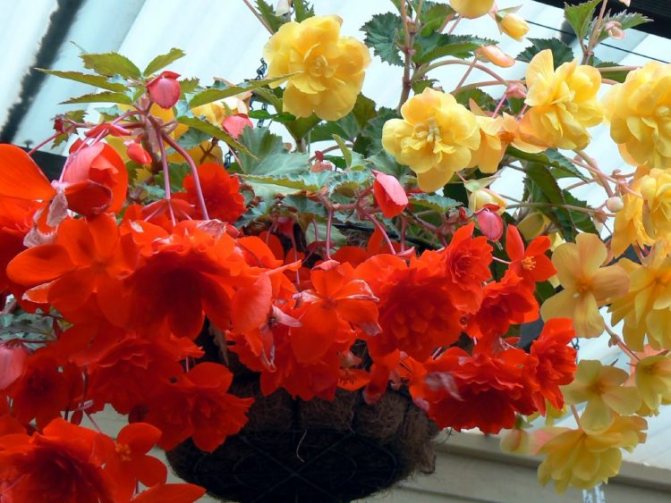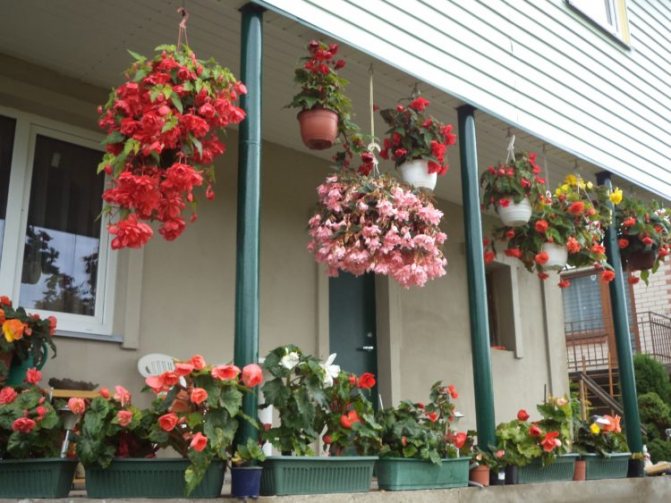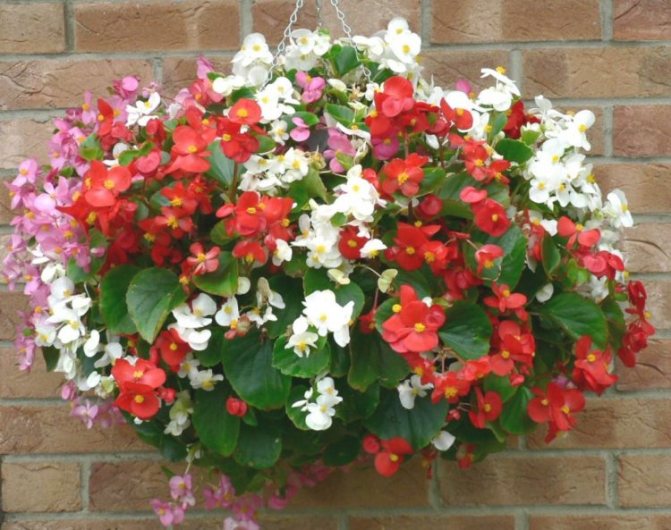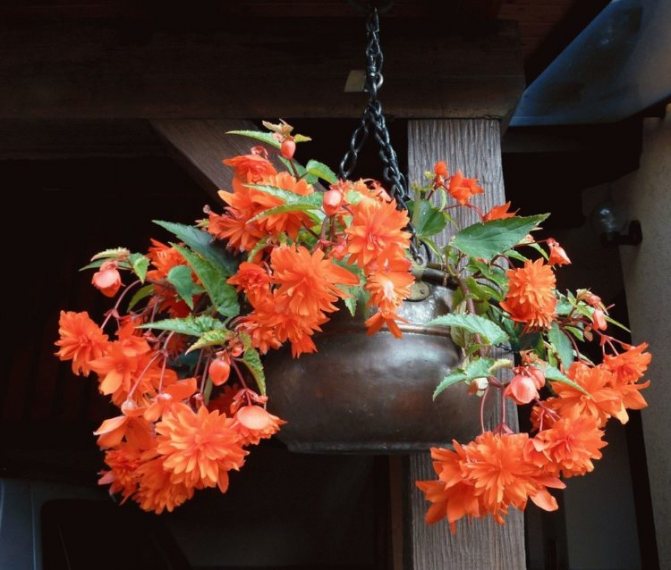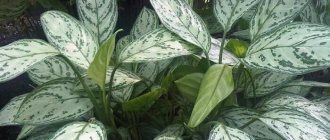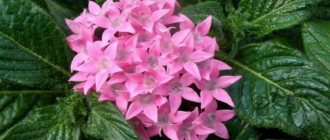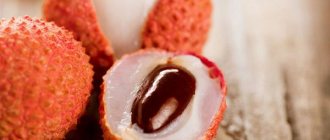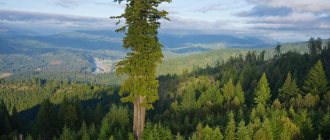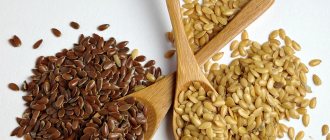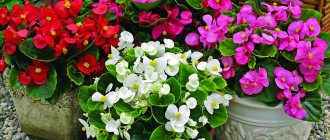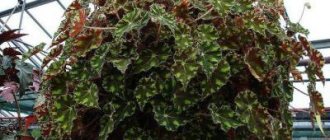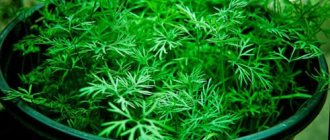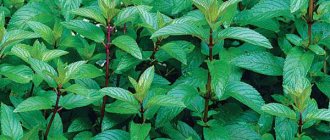Bolivia Begonia is a wonderful annual plant with orange-red flowers, ideal for large hanging baskets, containers, flower beds and can be grown as a houseplant. Young plants grow upright at first and then produce a large number of side shoots hanging from baskets. If it grows in a flowerbed, it has a lodging appearance.
There are about 15,000 hybrids of these popular plants. Most of them are grown as houseplants, mainly for their beautiful, often exotic colored foliage, others for their attractive, abundant and long lasting flowers.
What is this plant?
In the 17th century, during a scientific expedition to islands near South America, botanists came across an unusual plant. Three years were not named, but after this time they designated it among other plant cultures, naming it in honor of the organizer of the scientific expedition, Mr. M. Begon. Over time, more and more new species were discovered, exploring forests in South America, India, Asia and Africa.
Reference! Today, in the wild, there are more than one thousand species of begonias, and there are ten times less hybrids growing in apartments.
Why not decorate your apartment with a pot of this plant? They fall in love with ampelous begonia because of the brightness of the flowers and unpretentiousness.... She has semi- or double flowers framed by asymmetrical spotted leaves, because of which many beginner growers confuse her with peonies or camellias. She rarely grows above 50 cm.
On the pages of our site you will find a description of other species and varieties of this plant. Read about begonia Smaragdova, Maple-leaved, Tiger, Diadem, Elatior, Hogweed, Royal, Griffith, Terry and Bauer.
Varietal variety
Against the background of the popularity of ampelous begonias, many varieties and hybrids have been bred. They differ in appearance - the length of the shoots, the color and texture of the petals, and resistance. Popular varieties:
- Bella... A variety of European selection. The plant forms a powerful fleshy stem, large leaves. Recommended only for growing in an apartment. The flowers are creamy white;
- Chanson... The most popular varietal group. Its distinctive feature is the increased diameter of the buds, dense double petals. Shoots grow up to 25 cm in length. The color of the flowers is yellow, red or white, salmon;
- Pendula cascade yellow... An ornamental variety with dense, bright yellow flowers. The leaves are asymmetrical, the shoots are fast growing;
- Cascade florence... A perennial and compact plant, ideal for growing in an apartment. The stem and leaves are colored light green. Rose buds are very lush and voluminous;
- Illumination pink... A popular variety in Western countries that forms dense shoots up to 30 cm long. Leaves of a rich green color are heart-shaped. Double pink buds.
Bolivian begonia is also included in the ampelous group. This variety is distinguished by the peculiarity of shoot growth. They first grow vertically and then fall down, forming a living cascade.The most interesting varieties of this species are Copacabana, Bossa Nova and Santa Cruz Sunset F1. When choosing a plant, it is important to consider where you plan to grow it, as well as the appearance and volume of the bush.
Growing conditions
In order for ampelous begonia to please with an abundance of flowers, it is important to organize proper care for it. What temperature should be kept in the room? What should be the humidity?
Temperature
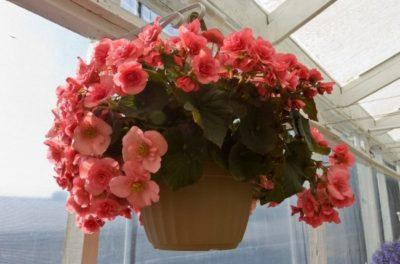
Ampel begonia grows at home if the room temperature is + 14-22 degrees Celsius. If it grows strongly, the plant will stop growing and developing. With the onset of winter, they provide peace for the flower... Begonia growing in the garden is dug out to remove the tubers in a place where the temperature will be + 5-12 5С.
The room temperature should always be the same as described above. Drafts are avoided when ventilating.
Lighting
Ampel begonias do not like direct sunlight. They are placed on the windowsill, where the light, although bright, is diffused. Under the bright rays of the sun, the pot with it is kept only for 2-3 hours in the morning and in the evening, i.e. raise the reflective film. The abundance of sunlight will come in handy at the end of summer, when the air temperature begins to gradually drop.
Humidity
Homeland begonias - countries with a tropical climate... Ampelous begonia loves heat, but the humidity is maintained around 60%. The first spraying is done in early spring, until the buds have formed. Water droplets should not fall on leaves and petals. Because of them, they turn yellow, which makes it difficult to find the flower beautiful.
Attention! What if the weather is hot at the end of August? The plant will suffer without additional refrigeration. At this time, a pallet helps a lot, which is placed under the pot, having previously filled with wet pebbles, peat or sawdust.
Read about the cultivation and reproduction of ampelous begonias in this article.
Tuberous plant transplant
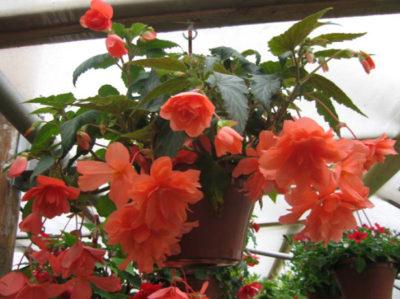

The ampelous begonia is transplanted only when necessary: the pot has become small or there are problems with the root system. The transplant is carried out in early spring.
- The plant is carefully removed from the old container, the roots are cleaned of the old substrate, treated with potassium permanganate or fungicide, and decayed parts are cut off.
- The new container is not completely filled with soil, a plant is placed in it and sprinkled with earth.
- The transplanted begonia should be watered frequently, and direct sunlight should also be avoided.
Important! When choosing a flower pot, you should stop at a shallow but wide container. A prerequisite is the presence of a drainage hole for the drainage of excess water.
It is also necessary to think over in advance the location of the future plant, since it may be necessary to attach fastening systems for the container in order to ensure that the stems of the ampelous begonia can freely fall.
How and when can you plant and replant?
A good example of ampelous begonia is obtained if the tuber is strong and healthy (read about tuberous begonia here). In a flower shop, they do not buy the first one they come across, but only the one that is healthy and will exceed three centimeters in diameter. When choosing tubers of small-flowered varieties, preference is given to peeled specimens that are free of spots and damage. They should have a tight top, and any buds that look like bumps and bumps should not be damaged.
Before planting the tubers in the ground, keep them with the lower, convex side on a cloth soaked in water. Wet sand can be used instead. So that the planting material does not disappear, it is sprayed from time to time with water or Epin's solution. When the buds give tiny white roots, you can plant the tubers in the ground. The plant is transplanted when it no longer fits in the pot... They choose a more spacious container and simply transfer the ampelous begonia into it.
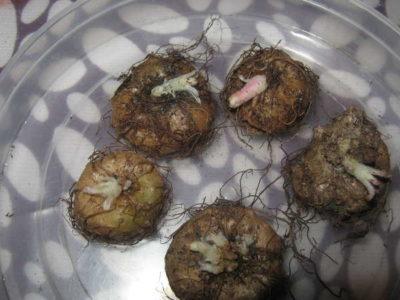

They remember that it is better to choose small and wide pots in which drainage holes are made, and then a drainage layer formed from petioles and expanded clay is laid. After sprouts appear on the tubers, they are planted in nutritious and loose soil, pre-treated with a fungicide. They are planted with the convex side on the soil spilled with water. The upper part is not covered with earth until visible shoots appear.
After planting, keep the pot with the transplanted begonia in a warm and bright place. Water it from time to time, but with great care so that drops of moisture do not fall on the tuber. With the appearance of the third leaf, the tuber is sprinkled with earth.
Useful video about planting ampelous begonia:
Picking, feeding and reproduction
As a rule, begonia is fed with organic fertilizers 2 times a year. For the very first procedure, nitrogen fertilizer is chosen. It is brought in during the period when the flower is just beginning to grow. Then, during budding, potash and phosphorus fertilizers are used. In just a season, you can fertilize the plant 3-4 times. Experienced flower growers recommend occasionally feeding the begonia with special vitamins.
For better flower growth, it should be dived. The first procedure is carried out after 6 weeks. Usually 2-3 sprouts are removed. They are transplanted into a separate pot. The next pick takes place 6 weeks after the first one. Once the plant has taken root, you can start fertilizing it.


You should be aware that after the flowering period, the shoots of the plant begin to dry out and it falls into a "dormant period". It is this time that is used for flower reproduction. There are 3 breeding methods:
- seeds;
- tubers;
- cuttings.
To obtain seeds, begonia is artificially pollinated. The best time for planting seeds is December. The seeds are planted in leafy ground, then covered with a jar and create a greenhouse effect. The soil must be watered periodically. In addition, it is important to maintain a temperature regime of + 25 ° C. The first shoots appear in about 2 weeks. Seed plants bloom 150 days after planting.
Tuber propagation is the easiest way. While ampelous tuber begonia is "in hibernation", the rhizomes must be removed from the ground, cleaned of soil and sprouts and stored in peat. There should be more than 7 buds on the tuber, then it will be accepted faster. The shoots are kept at a temperature of + 5 ... + 12 ° C. They can be placed in the ground after the first shoots appear.
When transplanting stems, you need to be careful not to damage the main flower. In general, this method is similar to tuber propagation. In winter, a stem cutting with leaves is separated from the top of the plant. After that, it is planted in the sand, watered a little and covered with a jar, while avoiding excess moisture. After about 3 weeks, the cutting will harden and then it can be transplanted into the ground.
Caring for begonias is pretty simple. However, it is recommended to pay attention to some problems. On the flower itself, 2 types of buds appear - large and small. If large flowers begin to fall off, it means that the plant is faced with some kind of problem. The most common case is an excess of water. Watering should be stopped immediately. Do not overdo it with fertilizers: the flower does not like strongly salty soils.
How to take care at home?
Experienced florists keep ampelous begonia in the west window... The sun's rays illuminate it from 11 to 15 hours. With moderate watering without waterlogging the substrate, it will soon bloom. To speed up the flowering process, they feed it. What rules are important to follow when feeding and watering?
Top dressing
For rapid growth and elegant flowering, a young flower is fed with nitrogen fertilizers.When dialing colors, they change them to others - for flowering plants, in which there will be little nitrogen, and a lot of potassium and phosphorus. Sometimes ampelny begonia is fed with fertilizers in a chelated form, in which there are many useful microelements. Organic fertilizers are applied no more than 1-2 times a year.
Important! Feeding with nitrogen-containing fertilizers is stopped as soon as they notice that the stems on the ampelous begonias have become watery.
Watering
In winter, begonia is not watered, but simply maintain the humidity around 60% by pouring water into a tray with moss under the pot so that the tubers do not dry out. Watering is slowly reduced from the onset of October... It is renewed with the onset of spring. They never pour water into the middle of the flower, so as not to provoke root rot.
How to pinch?
Experienced flower growers do not recommend pinching ampelous begonia. Pinching depletes the strength of the tuber. Better to leave it as it is. Because of this, the ejection of the buds will occur later than expected. To return everything to square one, they cut them off, seeking to build up the stem and prepare for the accumulation of a large amount of nutrients in the tubers. If the plant is very elongated, support is substituted and suspended.
Bolivian begonia care
- Watering.Keep the soil moist, but let the begonias dry out between waterings. More frequent watering is required indoors during months when the air is dry from heat sources or when plants are outdoors in the sun. Make sure the soil has sufficient drainage so the roots don't rot from too much water.
- Top dressing.For even flowering, fertilize begonia once a month, fertilizing according to package directions. Do not overdo it as this can burn the plant.
- Provide adequate lighting.Grow begonias outdoors in partial shade or indoors with bright indirect light. South-facing windows provide the most stable sun for houseplants, but begonias are sufficient for any room in the house with access to daylight.
- Begonia transplant.Begonia plants stop growing if the roots are intertwined in a container. Spring is the traditional season for transplanting begonias. Move the plant to a large container or split it up. To separate root-related plants, carefully lift the plant out of the container and carefully pull out the roots. Return about half of the original plant to a container of fresh soil.
- Pruning... Pinch or trim the long-legged begonias to shape them. If you are planting a rooted plant, trim the tops to about the same size as the root ball.
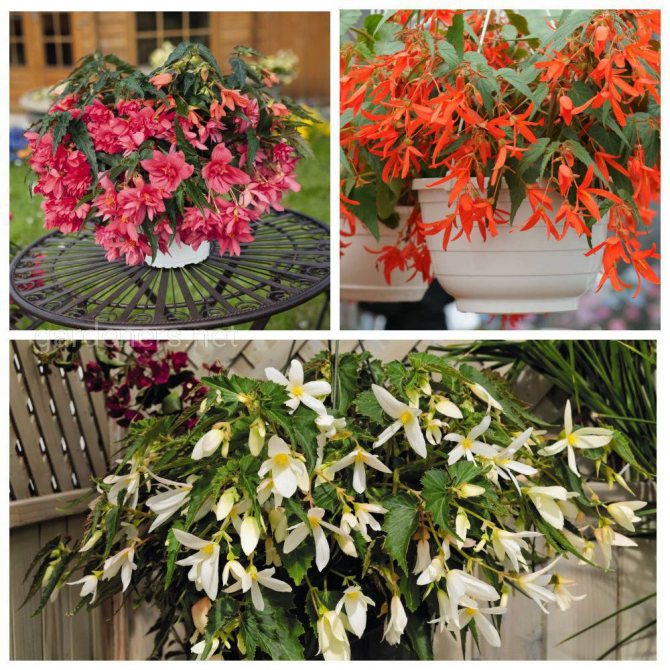

Features of keeping in the open field
Planting an ampelous begonia in open ground, carefully prepare the site for planting. They make holes, and peat and compost are poured into them. If they are not at hand, you can pour mineral fertilizers containing phosphorus and potassium into them. Before planting a plant in open ground, spill it with water. The main thing is to loosen the soil of the plant growing in the garden.... This will give the roots the oxygen they need to grow. Watering frequency is once every three days.
On hot days, it is watered even more often, and immediately after watering, the soil is loosened so that moisture stagnation does not lead to rotting of the roots. The flower growing in the garden is not sprayed. Otherwise, brown spots will appear on its leaves. Watering is stopped with the onset of late autumn.
Features and preferences of Bolivian begonia
Begonia boliviensis is a tuberous begonia originating from a rock-dwelling species that is extremely sensitive to water and cold. She needs at least 14 hours of light, temperatures above 13C, and constant feeding with high nitrogen levels for vigorous growth.
This species should not be grown like traditional tuberous plants or other types of begonias. Dropping them too early, when the days are short and the temperature is low, will lead to illness. The later the Bolivian begonia is planted, the easier it will grow and the faster it will bloom.


Photo
Below you can see a photo of ampelous begonia flowers and care for this plant.
Ampelous begonia from seeds: growing
It should start with the fact that it is recommended to grow this plant from seeds at the end of February or at the beginning of March - it is then that the duration of daylight hours actively increases, and the activity of the sun increases noticeably. Thanks to all this, it will be much easier to maintain the required temperature.
Stage one. We prepare the planting material
Ampel begonia "Alkor F1" Ampel begonia "Carmen F1" Ampel begonia "Venus" Seeds. Begonia non-stop f1, orange
Start your work with the selection of high-quality and most convenient seed for yourself. In specialty stores, you can buy begonia seeds, which can be of two types.
- Granular - such seeds are more convenient to sow, because they are large due to the special coating of nutrients. Ideal for spot seeding using peat or coconut tablets.
- Not granulated (conventional) - they do not have a nutritive shell, which means they are smaller and are most suitable for sowing in special seedling containers.
Stage two. We sow the seeds
The sowing procedure depends on what kind of seed you are using. Let's get acquainted in more detail with each of the two possible options.
Option number 1. We use granulated seeds
Such seeds, as noted earlier, are more convenient to sow, and they are more suitable for sowing in peat tablets (or in coconut, but the procedure will look the same). This method is convenient in that it allows you to do without picking, which is so dangerous for developing young plants.
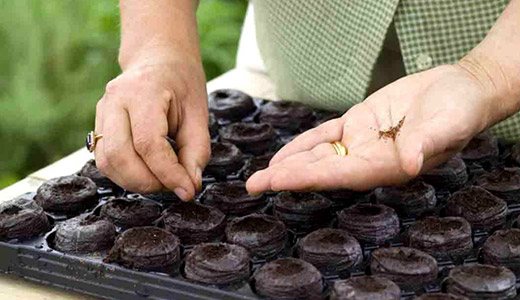

How to plant seeds in peat tablets
For sowing, first take the tablets themselves, place them on a tray and soak thoroughly with water. After that, put granulated seed on top of each tablet, lightly sprinkle with water (the temperature of the latter should be room temperature), which is more convenient to do with a spray bottle, and put something on top to maintain the required moisture level (this can be a plastic cup, PET bag, etc.). In the future, pour the tablets through the tray. Monitor the humidity level with special care, because the sprouts that appear can easily dry out.
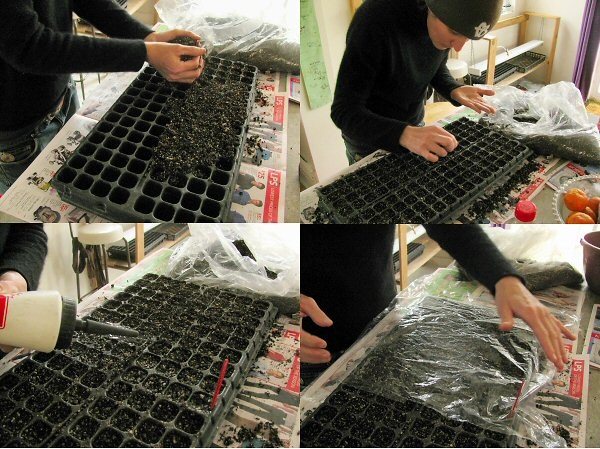

Planting seeds in a cassette with cells
You can also plant such seeds in cassette-type containers: place two granules in each cell filled with earth and press them a little (this will accelerate the dissolution of the shell), and then cover the container with something. It is also important that you take about one and a half to two times more seeds than the output plants require. For example, if you need 20 seedlings, then buy 40 seeds.
Video - How to use peat tablets
Option number 2. We use ordinary seeds
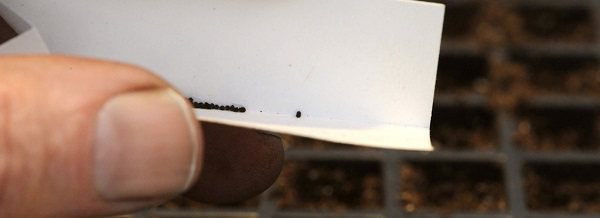

Ampel begonia seeds
In this case, use seed boxes for sowing. The soil should be slightly acidic, as close to neutral as possible.
To prepare the soil mixture, use:
- sheet soil;
- sand;
- sod soil.
On a note! Due to the fact that mold can attack begonia seeds, it is advisable to rinse all the ingredients that will be used for the mixture with water and heat them in an oven for half an hour.
Then mix sand, turf and leafy soil in a 1: 1: 4 ratio. Try to prepare the soil before the frost hits. Or, alternatively, buy ready-made soil.
Sowing ordinary seeds is not easy because they are very small (there are about 60,000 seeds per gram).For this reason, start by moistening the soil in the trays, preferably 24 hours before planting. Also, do not forget about the drainage ("cushion" of small stones), which must be laid on the bottom of the boxes before backfilling with soil. Next, take the seeds and distribute them evenly over the surface, then cover with glass or plastic. It is not worth watering immediately after sowing, since the seeds will be dragged deep into the ground by water, which may prevent seedlings from appearing.
The temperature in the room where the seedling box will be located should be about 24-25 ° С - this way the seedlings will appear more "amicably". As for the germination time, it ranges from 9-25 days.
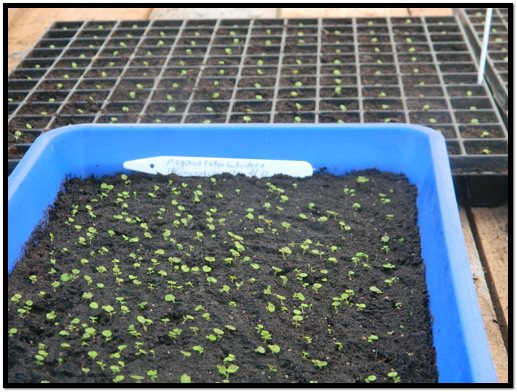

Seedlings of ampelous begonia in a container - photo
Video - Sowing begonia seeds
Stage three. We take care of seedlings
When the first shoots begin to appear, try to protect them from direct sunlight, and also do not allow the soil to dry out. The seedlings will then be very tender, so give preference to the bottom watering (put the boxes in a tray filled with water). You can also lower the temperature a little - somewhere down to 21 ° C.
If seedlings appeared in January, then they will suffer from a lack of natural light (this month the days are still quite short). Plants will be underdeveloped and weak, most of them will die altogether. In this case, think about providing piece lighting in advance. Ideally, seedlings should be under constant lighting for at least 12-13 hours a day. At first, the additional lighting will work even after midnight, but when the length of the day begins to increase and the seedlings develop, this time will gradually decrease.


An example of arranging artificial lighting
On a note! You will also have to gradually harden the seedlings - slightly open the film and keep the boxes in this position for 15 minutes. Increase both the film opening and hardening period daily to allow the begonia to become accustomed to its natural environment.
Thanks to this, you will prevent the development of fungi, which inevitably appear with excessive watering and non-observance of the temperature regime.
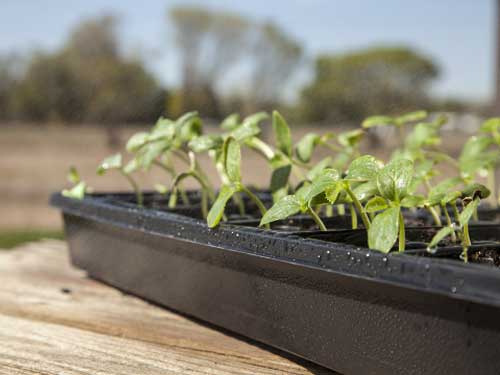

An example of hardening seedlings in the fresh air
Stage three. Picking
If you use peat tablets for cultivation, then picking is not required. If the above temperature regime was observed, then the first shoots will appear in two weeks. Later, when each plant has three true leaves, transplant the seedlings along with the peat mass and cover with a layer of soil. Sprinkle a little water on top. Actually, that's all.
In the case of ordinary seeds, everything is somewhat more complicated - about 50 days after sowing, the seedlings must be dived. If you plan to sell seedlings, then transplant them into separate cups: take the same soil that was used for sowing, equip the drainage at the bottom and fill each of them (cups) with soil so that about 1 cm remains to the edge. so that the cups are at least 10 cm high. If you are making hanging baskets, then take wide flat pots and dive four to five plants at a time.
Arrange the cups so that the seedlings are well lit and do not need to be rearranged / turned over from time to time. At the same time, lower the temperature a couple more degrees. The stems will stretch naturally, so there is no need to use growth stimulants. However, two weeks after the pick, you need to apply complex fertilizer; in the future, the plants should be fed at the same intervals. Use nitrogen fertilizers during the growing season, and only phosphorus-potassium fertilizers during budding and flowering.


Cups of seedlings exposed to the sun
After about 20-22 weeks, the seedlings will grow to a size at which it can be transplanted to a permanent place. Often, ampelous begonias are planted in hanging baskets and pots, placed on balconies, terraces or verandas. Already at the beginning of summer, the first flowers will open. The flowering period itself is quite long (lasts until the first frost), but if the pots are brought into the room, the begonia will bloom a little longer.
On a note! The flowers on this plant are of two types - male (large) and female (small). In case of insufficient care, large flowers can fall off, due to which begonia will lose its decorative effect. That is why it is necessary to strictly observe the agrotechnical requirements described in the article.


Fertilizing ampel begonias
Video - Accelerating the development of begonia
Possible problems
Sometimes ampelous begonia withers away. Florists notice that her leaves dry and fall. Brown specks may also appear on the tips. To avoid problems, conditions of detention and care are being reviewed.
Reference! Most plant problems arise from improper and untimely watering.
Pests and diseases
- Powdery mildew is a fungal disease caused by microscopic ectoparasitic fungi... It affects ampelous begonia. Leucorrhoea or white bloom is noticed on the leaves, fruits and ground parts of the shoots. In order not to cure the plant, they examine it regularly and are alerted when they see the characteristic signs described above on leaves located close to the ground. They are immediately removed, and the flower itself is treated with the Topaz fungicide.
- Another dangerous pest is spider mite... He often appears indoors with dry air. To combat it, they review the frequency of watering and make sure that the ampelous begonia receives a sufficient amount of sunny color. Otherwise, it will lose leaves and wither. Spider mites are fought with the modern insecticide Bi-58 Novy, treating the plant with it as written in the instructions.
For those who want to start breeding and growing begonias, we have prepared materials about different types of this plant. Perhaps it is our articles that will help you make the right choice. Read about these varieties: Tiger, Naked, Gray-headed, Mason, Metallic, Collar, Imperial, Coral, Rex and Fista.
Application in design
Ampel begonia fits into any interior of the apartment. Suitable for growing on the wall in a hanging planter or on furniture. Most flower growers prefer to decorate a balcony, terraces and summer cottages with a plant. The bush looks especially decorative when the pots are arranged in groups. A combination of different varieties is allowed in order to achieve a beautiful cascade of live flowers.


Reproduction methods
Imperial begonia can propagate both by cuttings and from seeds, some parts of the leaves, or even separation of roots.
Cuttings
To begin with, it is necessary that the cuttings take root, for this you need to place them in water. Also, the roots will quickly develop and grow in normal soil. with the addition of stimulants. It is necessary to cover the pot with the plant with a film to create a greenhouse effect. It will be better to warm up the soil before this.
Using parts of leaves
This is a good breeding method for imperial begonias. To do this, you need to place a leaf on the glass. Divide into triangles with a knife.
IMPORTANT! The vein should be located at the tip of the leaflet.
Next, lay them on the ground and cover with foil, after pressing the leaves tightly. It is necessary to ventilate every day. Shoots will be visible in about a month.... To transplant, you need to wait for the shoots to get stronger and carefully plant for independent development and growth.
Reproduction using roots
Another way to breed begonias. It is necessary to divide the root system into a favorable crumbly soil.For the emergence of sprouts, you should wait very little time.
Imperial begonia is unpretentious in everything and does not require special care (you can learn more about the nuances of caring for an imperial begonia here). In horticulture, it has become very widespread, about 125 species. At the moment, there are a large number of varieties and sizes of begonias.... The varieties that were bred in Belgium are the most popular. At the moment, the sale of Bolivian begonias is comparable to the sales of the popular crops of the balsamic variety. In 1920, the asteroid was named after the begonia.
If you find an error, please select a piece of text and press Ctrl + Enter.
General information
The birthplace of Bolivian begonia is the eastern part of the Andes. This plant has elongated, graceful green toothed leaves, drooping thin shoots and small orange-red flowers grouped in two or three on short peduncles and looking like elongated bells facing downward. Under natural conditions, Bolivian begonia usually grows apart in rock crevices near streams. She feels great in the foggy atmosphere of mountain forests, on the basis of which it is easy to get an idea of the conditions of her maintenance.
This plant belongs to tuberous crops. Its maximum height is thirty to forty-five centimeters, and the length of the creeping or hanging down stems is eighty centimeters. Bolivian begonia grows superbly in a small amount of soil. It was this quality that aroused interest in it on the part of breeders, who began to develop special varieties for breeding in portable containers, pots and hanging baskets.


Plant propagation
Cultivation of new plants of tuberous begonias is possible by propagation by green cuttings, seeds or dividing the tuber.
- Tuber divisionused for plant propagation in greenhouses. Moistening of plantings is carried out very carefully, ensuring the spraying of irrigation water over the soil surface. Watering is carried out periodically, keeping the soil sufficiently moist. Overflowing the cut during this period, when the roots and shoots are not yet branching, will have a detrimental effect on the development of plants. Tuber division is practiced when propagating rare plant varieties.


Features of planting a plant
To get a healthy, beautifully flowering plant, it is important to choose the right planting material. The begonia tuber should be large, at least 4 cm in diameter, without dark spots, concavities, soft areas and other signs of fungal infections. On the upper part of the tuber, you can see tubercles - future buds, of which there should be 3 or more.
The soil optimal for begonia should have a slightly acidic reaction, be loose, moisture and air permeable, and at the same time nutritious. This can be achieved by mixing 4 parts leafy soil, 1 part high-moor peat and 1 part sand. It is advisable to add perlite to the mixture for better moisture exchange. If you replace high-moor peat, which has an acidic reaction, with neutral coconut fiber or low-lying peat, the soil is additionally acidified with chopped moss sphagnum.
The begonia pot is chosen based on the characteristics of the bush and root system, low and wide. If you plan to hang bushes, containers should be equipped with fixed pallets. So you don't have to worry that excess water will be spilled. Ampelous begonias in flowerpots with high legs look great.
Before planting, the tubers are laid out with their underside on pallets with wet sand or peat. You can use a soft cloth. The main thing is to maintain a high level of moisture, while avoiding direct contact of the tubers with moisture. Containers with planting material are exposed to light. Periodically they are sprayed with Epin, Zircon or another root stimulator and a weak solution of potassium permanganate. When small roots appear on the convex part of the tubers, they are ready for planting.At a temperature of 20-25 degrees, the preparatory stage takes about a week.


Planting tubers is not difficult:
- In a prepared pot with a diameter of 12 cm, a layer of drainage and soil is laid so that 1/4 of the container remains free.
- The soil is watered abundantly.
- The tuber is placed on the ground, pressing slightly. If you plant several specimens in one pot, there should be 4-5 cm of free space between them.
- Freshly planted tubers should never be covered from above.
- The pots are placed in a well-lit, warm place.
- Before sprouts appear, watered carefully, trying to avoid getting water on the tubers.
- After the sprouts grow up to 5 cm and get stronger, you can pour on top of the earth.
If you fall asleep the tuber earlier, the sprouts will not hatch. Therefore, wait for the awakening of all the kidneys. An adult strong tuber is able to "stretch" up to 7 shoots. It is better to remove the excess immediately. The soil level above the tuber should not exceed 3 cm.A month later, the bush is transferred into a pot with a diameter of 20 cm.
Recommended to read
Home care for Hyacinth in a pot
Home care for Chrysanthemum in a pot
Home care for Kalanchoe
Home care for the Venus flytrap flower
Biological description of the plant
Ampelous begonia is a perennial shrub-shaped plant. The stems reach a height of several centimeters, after which they grow on the sides, forming a hanging bush. The leaves are of different colors, mostly small. Flowers from white to bright red tones, grow profusely and bloom for a long time.
It is interesting that two types of flowers grow on ampelous begonias:
- male;
- female.
Moreover, only the first have the largest size and decorative value, and the women are small and rather modest. If the plant is going through an unfavorable period (for example, excess moisture, poor soil, too high a temperature), then it sheds male flowers. Therefore, the rapid death of the buds, the falling petals are a reason to pay attention to your pet and quickly take action.
Ampel begonias can grow from tubers, propagate by cuttings, dividing a bush, or using seeds. Moreover, from a decorative point of view, non-tuberous representatives of the plant are very interesting. They retain the ability to bloom throughout the year. But the tuberous cousins develop according to the classical scenario: in the spring they grow vigorously, in the summer they give flowers, after which they leave for winter rest.
NOTE
When growing a tuberous ampelous begonia at home, it is important to take into account one important rule of care. Often, fresh sprouts can appear on the tuber even in winter.
Then it is better to plant the tuber and illuminate it during the day with special lamps for plants so that the total duration of daylight hours is at least 12 hours. With proper care, such a tuber will begin to grow rapidly, and in the spring it will give its lush flowers.
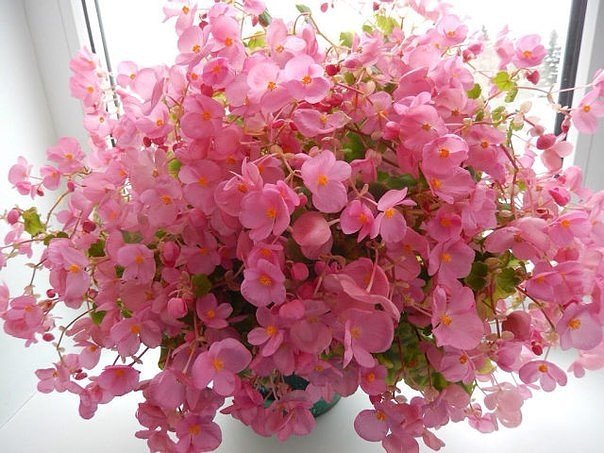

Ampelous begonia varieties
There are dozens of plant varieties, and almost all of them are of hybrid origin. That is, all these plants were specially bred by breeders and adapted to the peculiarities of our climate. In everyday life, varieties of this flower are often called by color: for example, white ampelous begonia.
Although, of course, there is also a scientific classification. As a rule, breeders distinguish series, within which specific varieties are distinguished. For example, the "Chanson" series includes the following varieties:
- white;
- salmon;
- pink;
- vanilla yellow;
- copper and many others.
When breeding a particular variety, it is important to take into account that propagation methods such as cuttings, growing from a tuber, or dividing a bush will give an exact copy of the mother plant. But reproduction by seeds does not guarantee one hundred percent similarity with the parent.
Bloom
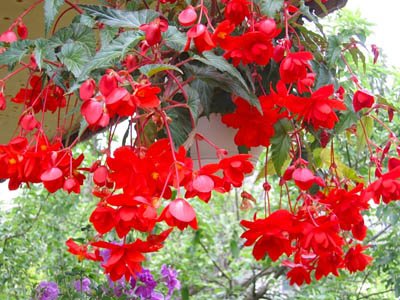

For a long period of flowering, this plant is called ever-flowering. From May to November, the begonia is strewn with ampelous flowers. Male flowers are larger, more elegant, double, female simple, consisting of only 2-5 petals. One flower lasts about ten days, and new ones immediately appear to replace it.
The rest period lasts about 3.5 months - from November to early March. At this time, she does not need to be disturbed (but remember about a very unhurried, accurate watering).
To make begonia bloom: 10 helpful tips for grooming
Caring for begonias is not very difficult, but it is always worth remembering one important nuance. This plant originally came to us from tropical latitudes. This means that it especially needs a sufficient level of moisture, lighting and loves warmth.
Among the basic rules for growing ampelous begonias are the following:
- First of all, you need to try to place the pots in a place where there will be no constant direct sunlight. For example, it is good if the sun hits the plant before lunchtime and after 15-16 hours (southeast, southwest). And if this is not possible, you can simply place the begonias in the light shade of other plants or behind tulle. During the heat of summer, it is best to keep the pot away from direct sunlight during the day.
- Watering is carried out only with settled water. Moreover, in the case of tuberous plants, it is better not to get water on the tuber itself. And of course, water is not allowed on flowers and foliage. You can water either along the edge of the pot or pour water into the pan. The frequency of watering is determined by the condition of the soil: its surface should be barely damp. And when dry, you need to pour a fresh portion of water (in the summer 3 times a week, in the winter - less often).
- The plant normally withstands temperatures from + 15 ° C to + 27 ° C. However, the optimum is in the range + 18оС ... + 20оС. Frosts below + 13оС are undesirable. However, overheating can also negatively affect the condition of the flowers.
- Another rule of caring for ampelous begonia at home is to constantly maintain humidity in the air (especially in the summer). You can simply spray the air, being careful not to get on the foliage and flowers. In a hot period, it is advisable to add water to the pan so that it evaporates and gives additional moisture. If possible, you can also put a saucer of water next to the pot.
- The soil is purchased specifically for begonias (or soil for violets is quite suitable). Or you can compose it yourself: equal amounts of leafy earth, humus and coarse sand are taken. And you can also take the same amount of compost, peat and coarse sand, adding to them twice as much (in relation to one component) of ordinary garden soil. Just before planting an ampelous begonia, you need to take into account the golden rule of caring for almost all plants at home: the soil should be thoroughly loosened. It's a good idea to add perlite to it - then the earth will retain its porosity, and the roots will always receive a sufficient amount of oxygen.
- Also, when caring for ampelous begonia, you should pay attention to feeding. Too often it is not necessary to give fertilizers, and their concentration should be 1.5-2 times less than indicated in the instructions. The fact is that the plant does not like salting the soil. In the spring, as well as during flowering, they give potassium and phosphorus. It is permissible to use a complex mineral fertilizer on a monthly basis. In winter, the plant is usually not fed (except in cases of flowering). As for organic fertilizers, they can be given once or twice a year.
- You should periodically inspect your pet begonia, because its appearance speaks a lot about the state of health. Dry leaves, peduncles after flowering must be removed. There is another important rule for caring for ampelous begonia at home. Both during planting and during the rest of the period, make sure that there are no traces of pests (mites, aphids, fungi) on the foliage.More on this below.
- Pruning ampelous begonias is done with a sharp knife (if you use scissors, they can damage the fibers of the stem). Moreover, the plant should not be cut too short: it is better to leave at least 3 internodes on each branch, from which new leaves will grow. Sprinkle fresh cuts with wood ash.
- Another important rule: periodically, you should make a new planting of the ampelous begonia in a larger pot (5 cm larger than the diameter of the previous one). The flower grows well. And if the stems are deformed and elongated, and the flowers fade and quickly fall off, the reason is most likely precisely in cramped conditions. Otherwise, it may be associated with poor soil or poor watering.
- In winter, plant care is about the same, but watering is reduced, and fertilizers can be omitted. In addition, it is important to take care of a sufficiently warm (room temperature) and well-lit place. In most cases, an indoor plant will need additional lighting in winter. The total duration of daylight hours is at least 12 hours). If the balcony is well insulated and actually turned into an ordinary room, then the flower can be left there as well. However, when you open the window, you need to take it home: begonia really does not like the cold wind and generally drafts.
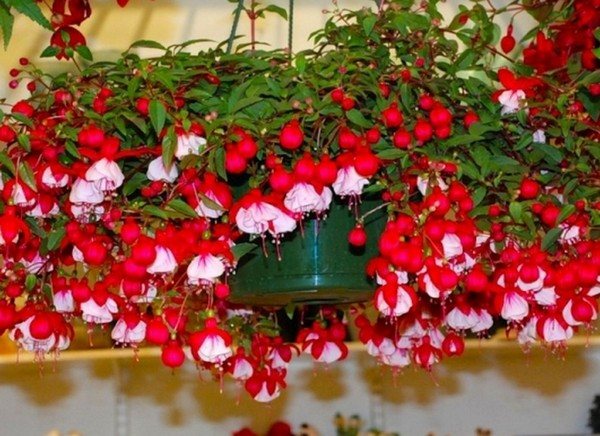

WHY BEGONIA GETS NON-TEXTURED FLOWERS
Large male flowers with double edges give special beauty to the ampelous begonias. If they appear quite rarely, this indicates that the care of the plant is not entirely correct. The most likely version is frost and lack of moisture. As soon as the conditions are normalized, the plant will surely please with new flowers.
Description of appearance and features
Bolivian begonia has a very attractive appearance. This plant has elongated leaves, beautiful flowers that outwardly resemble elongated bells. Hanging shoots. In nature, the plant lives apart.
REFERENCE! Begonia belongs to tuberous plants. It reaches a height of 30 to 45 centimeters. The stems are covered with green serrated leaves. There are usually two to three flowers per plant and are red-orange in color.
Botanical description
Tuberous perennial with self-contained stems and asymmetric leaves. The height of the stem is 20-60 cm, and the length of the leaves is 10-20 cm. Begonia Pendula is notable for its long (30-40 cm, and in some varieties up to 1 m) hanging shoots. For this, it is also called drooping begonia. She has unisexual, monoecious flowers of bright colors with a diameter of about 5 cm. Some varieties have larger flowers.
Not all amateur gardeners are ready for the fact that ordinary flowers bloom on the purchased terry begonia.
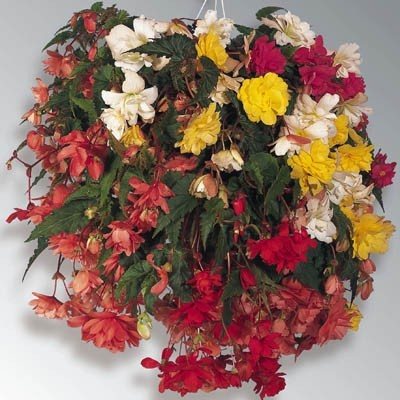

If this happened to you, do not be discouraged! These flowers are female. Take care of your plant, watch out for watering, and soon wonderful double male flowers will bloom on your begonias. We grow at home
In this section, we will talk about how to grow hanging begonias on our own.
Pests and diseases of ampelous begonia
Ampelous begonia is not a painful plant, but it also gets in trouble. It is gray rot - rot on the leaves and shoots of a flower; powdery mildew - white bloom on the leaves; bacterial spotting is a disease of the back side of begonia leaves. Spraying with special solutions will help from these misfortunes.
Of insects, soft false shield, aphid, whitefly and others are harmful. Spraying is also suitable to combat them (choose a remedy based on the parasite), and in some cases it may be necessary to remove part of the plant. Try growing ampelous begonia next summer and you will be delighted with this flower. Gentle or passionate - she will lift your spirits anyway.
Reproduction
Begonia ampelous propagates by seeds, cuttings, tubers.
The most laborious breeding method is growing ampelous begonias from seeds.They are really tiny: 50,000 per gram of raw seed. They are sown on loose soil, without sprinkling them on top with a layer of soil. Cover the top with a film to keep moisture and heat inside. All this time, constant watering is required so that the seedlings do not dry out. After 3 months, the plant dives into the pot.
Cuttings Is the most affordable way to grow begonia. Place 10-centimeter cuttings of overwintered begonias in water and wait for sprouts to sprout. Then plant the cuttings in pots, 5 cuttings per pot.
With tuberous propagation, cut parts with 2-3 buds are sprinkled with charcoal powder. Another option is colloidal sulfur. So they are dried, and then planted in the usual way.
Variety "Santa Cruz"
One of the most common seed-grown Bolivian begonia hybrids is the Santa Cruz variety. These plants, at the very beginning of development, are small shrubs with vertical shoots, which later elongate and bend. After some time, the wide bush grows to a height of almost thirty centimeters, and the length of the shoots reaches fifty centimeters. Long green, narrow leaves form a dramatic backdrop for many orange-red elongated flowers. The plant begins flowering fourteen to eighteen weeks after sowing the seeds. This variety feels great both in openwork shade and in well-lit areas.
Diseases, pests
Varieties of ampelous strawberry large-fruited and remontant
If the foliage and buds of the begonia began to fall off, this means that it lacks moisture in the soil and air.
If a whitish bloom is found on stems, foliage, it is powdery mildew. The affected areas should be cut off and the culture should be sprayed with fungicides.


Powdery mildew on begonias
If yellow spots are visible on the foliage, this means that a red spider mite attacked it. Plants are sprayed with a systemic insecticide.
Pruning
To get beautifully flowing twigs, Bolivian begonia must be properly pruned. This procedure promotes the rejuvenation of the plant and improves the quality of flowering.
Since the green mass will grow very quickly, pruning should be done in a timely manner. In case of untimely pruning, all the forces of the flower will be spent on building up greenery, and flowering may stop.
Bush-forming pruning is carried out with a stem length of up to 8 cm, upon reaching a length of 13 cm, the tops are cut off in order to activate the growth of lateral shoots.
Further, the procedure is carried out as the shoots grow, while the tops are removed, redirecting the growth to the side shoots, which, in fact, allows you to create a beautiful cascade.


Pruning is done not with scissors, but with a sharp knife, this reduces the invasiveness of the procedure.
General information and description
Ampel begonias are one of the hybrid varieties of tuberous begonias. The homeland of this group of plants is the forests of the tropical and subtropical zones. The ampelous begonias are distinguished by elongated, thin, prone to drooping shoots up to 40 cm long. Leaves are dark green, lanceolate, asymmetrical, with teeth along the edge. The tuber is flat-round, oblique, up to 6 cm in diameter.
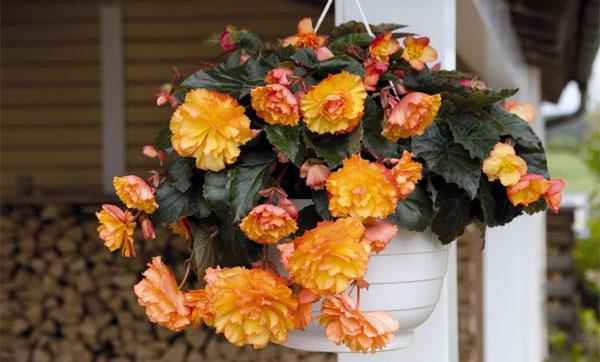

Under favorable conditions, after 5-6 leaves, buds begin to form in the axils. The flowers are large, up to 10 cm. The color depends on the variety; pink, white, orange, red colors and their shades prevail.
For example, the Bertini variety has red-orange flowers, medium (5-9 cm) in size; bushes branch well and practically do not need pinching.
In the F1 Alcor hybrid, the flowers are distinguished by an elegant shape due to the elongated lower petals. White with hot pink prints and stripes.
Margarita F1 is another hybrid with pale yellow petals. Fans of white begonias should pay attention to the Chanson series: within its framework, not only snow-white, but also salmon, champagne colors and even two-color hybrids are presented.
On one bush, begonias can have both double (male) and non-double (female) flowers. Ampelous begonia blooms, like other tuberous, mainly in summer.


Soil requirements
In flower shops special soil for begonias is sold. For indoor and balcony cultivation, it is perfect. It is not difficult to prepare the soil yourself. For tuberous species, the following mixture is good: two parts of leafy land from under large deciduous trees - one part of river sand - one part of turf land.
If begonias are planted in open ground, on a flower bed, then the best option for a plant is nutritious, loose soil... If the soil is not loose enough, you can add sand, season with leaf humus, peat. The soil must be well permeable to air.

